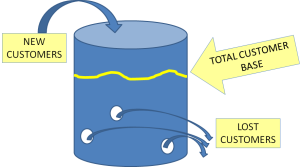The Leaky Bucket Theory or Analogy?
The leaky bucket theory is more of an analogy than a theory. It is used because it is a nice and simple way of understanding the concept of customer relationship management and how to increase customer lifetime value.
The theory uses a bucket that has several holes in the base and its walls. A hose is put into the bucket and it is filled with water. Some of the water will run out the holes. In the analogy, water going into the bucket represents new customers being acquired and the water flowing out of the bucket represents customers lost to the firm. The amount of water in the bucket represents the total customer base of the firm at that time.
As suggested by the analogy, this is quite a dynamic situation – as there is a constant flow of new customers and a consistent loss of existing customers. Therefore, size of the total customer base constantly varies – sometimes upwards and sometimes declining – depending upon the water flow into the bucket and the number of holes that water can flow out of.
The analogy is designed to highlight that the firm has two approaches it can take in order to maximize the amount of water in the bucket (that is, the size of the customer base). These two approaches are increasing the water flow into the bucket – in other words, increasing the number of new customers acquired. Or it can look to reduce or plug some of the holes in the bucket to reduce the water loss – in other words, concentrating on customer retention.
Therefore, the leaky bucket theory is a good analogy for the marketing challenge that firms face in determining the proportion of their marketing expenditure and activities that should be focused upon acquiring new customers versus retaining existing customers.
While this above point seems quite logical, it was not until the 1980s that firms started to realize the importance of customer retention and loyalty. Prior to that time the majority of marketing expenditure was focused upon acquiring new customers with little thought or effort focused on retention activities.
The leaky bucket theory is a nice introduction to the concept of acquisition versus retention, but it is a little bit too simplistic for the extent of challenges faced in this area – as should become apparent as you review the various articles on this website on understanding customer lifetime value.
